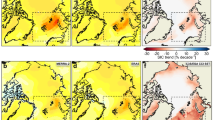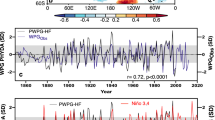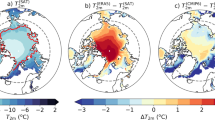Abstract
There is clear evidence that the West Antarctic Ice Sheet is contributing to sea-level rise. In contrast, West Antarctic temperature changes in recent decades remain uncertain. West Antarctica has probably warmed since the 1950s, but there is disagreement regarding the magnitude, seasonality and spatial extent of this warming. This is primarily because long-term near-surface temperature observations are restricted to Byrd Station in central West Antarctica, a data set with substantial gaps. Here, we present a complete temperature record for Byrd Station, in which observations have been corrected, and gaps have been filled using global reanalysis data and spatial interpolation. The record reveals a linear increase in annual temperature between 1958 and 2010 by 2.4±1.2 °C, establishing central West Antarctica as one of the fastest-warming regions globally. We confirm previous reports of West Antarctic warming, in annual average and in austral spring and winter, but find substantially larger temperature increases. In contrast to previous studies, we report statistically significant warming during austral summer, particularly in December–January, the peak of the melting season. A continued rise in summer temperatures could lead to more frequent and extensive episodes of surface melting of the West Antarctic Ice Sheet. These results argue for a robust long-term meteorological observation network in the region.
This is a preview of subscription content, access via your institution
Access options
Subscribe to this journal
Receive 12 print issues and online access
$259.00 per year
only $21.58 per issue
Buy this article
- Purchase on Springer Link
- Instant access to full article PDF
Prices may be subject to local taxes which are calculated during checkout





Similar content being viewed by others
Change history
23 December 2013
In the version of this Article originally published, some information in Fig. 3a,b and in the Supplementary Information was incorrect. A full explanation of the calculation errors and their corrections, including an updated Fig. 3a,b, can be found in the corresponding Corrigendum.
23 December 2013
Nature Geoscience 6, 139–145 (2013); published online 23 December 2012; corrected after print 23 December 2013. In our Article presenting a reconstruction of the near-surface temperature record at Byrd Station, a calculation error led to an overestimation of the magnitude and statistical significance of the temperature trends in December–January shown in Fig.
References
Rignot, E. Changes in West Antarctic ice stream dynamics observed with ALOS PALSAR data. Geophys. Res. Lett. 35, L12505 (2008).
King, M. A. et al. Lower satellite-gravimetry estimates of Antarctic sea-level contribution. Nature http://dx.doi.org/10.1038/nature11621 (2012).
Joughin, I. & Alley, R. B. Stability of the West Antarctic ice sheet in a warming world. Nature Geosci. 4, 506–513 (2011).
Jacobs, S. S., Jenkins, A., Giulivi, C. F. & Dutrieux, P. Stronger ocean circulation and increased melting under Pine Island Glacier ice shelf. Nature Geosci. 4, 519–523 (2011).
Pritchard, H. D. et al. Antarctic ice-sheet loss driven by basal melting of ice shelves. Nature 484, 502–505 (2012).
Steig, E. J. et al. Warming of the Antarctic ice-sheet surface since the 1957 International Geophysical Year. Nature 457, 459–462 (2009).
O’Donnell, R., Lewis, N., McIntyre, S. & Condon, J. Improved methods for PCA-based reconstructions: Case study using the Steig et al. (2009) Antarctic temperature reconstruction. J. Clim. 24, 2099–2115 (2010).
Schneider, D., Deser, C. & Okumura, Y. An assessment and interpretation of the observed warming of West Antarctica in the austral spring. Clim. Dynam. 38, 323–347 (2012).
Tedesco, M. et al. The role of albedo and accumulation in the 2010 melting record in Greenland. Environ. Res. Lett. 6, 014005 (2011).
Tedesco, M. & Monaghan, A. J. An updated Antarctic melt record through 2009 and its linkages to high-latitude and tropical climate variability. Geophys. Res. Lett. 36, L18502 (2009).
Kuipers Munneke, P., Picard, G., van den Broeke, M. R., Lenaerts, J. T. M. & van Meijgaard, E. Insignificant change in Antarctic snowmelt volume since 1979. Geophys. Res. Lett. 39, L01501 (2012).
Nghiem, S. V., Steffen, K., Neumann, G. & Huff, R. in Dynamic Planet: Monitoring and Understanding a Dynamic Planet With Geodetic and Oceanographic Tools, IAG Symp., Cairns, Australia 22–26 Aug. 2005 (eds Tregoning, P. & Rizos, C.) 31–38 (2005).
Chapman, W. L. & Walsh, J. E. A synthesis of Antarctic temperatures. J. Clim. 20, 4096–4117 (2007).
Monaghan, A. J., Bromwich, D. H., Chapman, W. & Comiso, J. C. Recent variability and trends of Antarctic near-surface temperature. J. Geophys. Res. 113, D04105 (2008).
Guo, Z., Bromwich, D. H. & Hines, K. Modeled Antarctic precipitation. Part II: ENSO modulation over West Antarctica. J. Clim. 17, 448–465 (2004).
Bindschadler, R. The environment and evolution of the West Antarctic ice sheet: Setting the stage. Phil. Trans. R. Soc., Ser. A 364, 1583–1605 (2006).
Ding, Q., Steig, E. J., Battisti, D. S. & Kuttel, M. Winter warming in West Antarctica caused by central tropical Pacific warming. Nature Geosci. 4, 398–403 (2011).
Shuman, C. A. & Stearns, C. R. Decadal-length composite inland West Antarctic temperature records. J. Clim. 14, 1977–1988 (2001).
Reusch, D. B. & Alley, R. B. A 15-year West Antarctic climatology from six automatic weather station temperature and pressure records. J. Geophys. Res. 109, D04103 (2004).
Küttel, M., Steig, E. J., Ding, Q., Monaghan, A. J. & Battisti, D. S. Seasonal climate information preserved in West Antarctic ice core water isotopes: Relationships to temperature, large-scale circulation, and sea ice. Clim. Dynam. 39, 1841–1857 (2012).
Lazzara, M. A., Weidner, G. A., Keller, L. M., Thom, J. E. & Cassano, J. J. Antarctic Automatic Weather Station Program: 30 years of polar observations. Bull. Am. Meteorol. Soc. 93, 1519–1537 (2012).
Dee, D. P. et al. The ERA-Interim reanalysis: Configuration and performance of the data assimilation system. Q. J. R. Meteorol. Soc. 137, 553–597 (2011).
Marshall, G. J. Trends in Antarctic geopotential height and temperature: A comparison between radiosonde and NCEP-NCAR reanalysis data. J. Clim. 15, 659–674 (2002).
Bromwich, D. H. & Fogt, R. L. Strong trends in the skill of the ERA-40 and NCEP-NCAR reanalyses in the high and middle latitudes of the Southern Hemisphere, 1958-2001. J. Clim. 17, 4603–4619 (2004).
Vaughan, D. G. et al. Recent rapid regional climate warming on the Antarctic Peninsula. Climatic Change 60, 243–274 (2003).
Hansen, J., Ruedy, R., Sato, M. & Lo, K. Global surface temperature change. Rev. Geophys. 48, RG4004 (2010).
Johanson, C. M. & Fu, Q. Antarctic atmospheric temperature trend patterns from satellite observations. Geophys. Res. Lett. 34, L12703 (2007).
Turner, J., Lachlan-Cope, T. A., Colwell, S., Marshall, G. J. & Connolley, W. M. Significant warming of the Antarctic winter troposphere. Science 311, 1914–1917 (2006).
Barrett, B. E., Nicholls, K. W., Murray, T., Smith, A. M. & Vaughan, D. G. Rapid recent warming on Rutford Ice Stream, West Antarctica, from borehole thermometry. Geophys. Res. Lett. 36, L02708 (2009).
Orsi, A. J., Cornuelle, B. D. & Severinghaus, J. P. Little Ice Age cold interval in West Antarctica: Evidence from borehole temperature at the West Antarctic Ice Sheet (WAIS) Divide. Geophys. Res. Lett. 39, L09710 (2012).
Lee, T. & McPhaden, M. J. Increasing intensity of El Niño in the central-equatorial Pacific. Geophys. Res. Lett. 37, L14603 (2010).
Mo, K. C. Relationships between low-frequency variability in the Southern Hemisphere and sea surface temperature anomalies. J. Clim. 13, 3599–3610 (2000).
Stammerjohn, S. E., Martinson, D. G., Smith, R. C., Yuan, X. & Rind, D. Trends in Antarctic annual sea ice retreat and advance and their relation to El Niño-Southern Oscillation and Southern Annular Mode variability. J. Geophys. Res. 113, C03S90 (2008).
Fogt, R. L., Bromwich, D. H. & Hines, K. M. Understanding the SAM influence on the South Pacific ENSO teleconnection. Clim. Dynam. 36, 1555–1576 (2011).
J. Atm. Sci. 62 (2005).
Haigh, J. D. & Roscoe, H. K. The final warming date of the Antarctic polar vortex and influences on its interannual variability. J. Clim. 22, 5809–5819 (2009).
Kwok, R. & Comiso, J. C. Spatial patterns of variability in Antarctic surface temperature: Connections to the Southern Hemisphere Annular Mode and the Southern Oscillation. Geophys. Res. Lett. 29, 1705 (2002).
Gillett, N. P. & Thompson, D. W. J. Simulation of recent Southern Hemisphere climate change. Science 302, 273–275 (2003).
Van den Broeke, M. R. & van Lipzig, N. P. M. Changes in Antarctic temperature, wind and precipitation in response to the Antarctic Oscillation. Ann. Glaciol. 39, 119–126 (2004).
Marshall, G. J. et al. Causes of exceptional atmospheric circulation changes in the Southern Hemisphere. Geophys. Res. Lett. 31, L14205 (2004).
Thompson, D. W. J. & Solomon, S. Interpretation of recent Southern Hemisphere climate change. Science 296, 895–899 (2002).
Nicolas, J. P. & Bromwich, D. H. Climate of West Antarctica and influence of marine air intrusions. J. Clim. 24, 49–67 (2011).
Bertler, N. A. N. et al. El Niño suppresses Antarctic warming. Geophys. Res. Lett. 31, L15207 (2004).
Turner, J., Phillips, T., Hosking, J. S., Marshall, G. J. & Orr, A. The Amundsen Sea low. Int. J. Climatol. http://dx.doi.org/10.1002/joc.3558 (2012).
Jacobs, S. S. & Comiso, J. C. Climate variability in the Amundsen and Bellingshausen Seas. J. Clim. 10, 697–709 (1997).
Ding, Q., Steig, E. J., Battisti, D. S. & Wallace, J. M. Influence of the tropics on the Southern Annular Mode. J. Clim. 25, 6330–6348 (2012).
Turner, J. et al. The SCAR READER project: Toward a high-quality database of mean Antarctic meteorological observations. J. Clim. 17, 2890–2898 (2004).
Kalnay, E. et al. The NCEP/NCAR 40-Year Reanalysis Project. Bull. Am. Meteorol. Soc. 77, 437–471 (1996).
Uppala, S. M. et al. The ERA-40 re-analysis. Q. J. R. Meteorol. Soc. 131, 2961–3012 (2005).
Jones, P. D. et al. Hemispheric and large-scale land-surface air temperature variations: An extensive revision and an update to 2010. J. Geophys. Res. 117, D05127 (2012).
Acknowledgements
This work was financially supported by the National Science Foundation (NSF) through grant ATM-0751291. The Antarctic Meteorological Research Center, provider of the AWS observations, is supported by the NSF Office of Polar Programs through grant ANT-0838834. We thank H. Brecher, R. Fogt, C. Genthon, T. Wilson and S-H. Wang for their insight/assistance at various stages of this work. We are also grateful to S. Colwell (British Antarctic Survey) for maintaining the READER database. This is contribution 1428 of the Byrd Polar Research Center.
Author information
Authors and Affiliations
Contributions
D.H.B., J.P.N. and A.J.M. designed the research. D.H.B. and J.P.N. performed the temperature reconstruction and wrote the paper. D.H.B., J.P.N. and A.B.W. analysed the results. M.A.L., L.M.K. and G.A.W. tested the AWS hardware and provided corrected AWS data. All authors commented on the manuscript.
Corresponding authors
Ethics declarations
Competing interests
The authors declare no competing financial interests.
Supplementary information
Supplementary Information
Supplementary Information (PDF 6870 kb)
Rights and permissions
About this article
Cite this article
Bromwich, D., Nicolas, J., Monaghan, A. et al. Central West Antarctica among the most rapidly warming regions on Earth. Nature Geosci 6, 139–145 (2013). https://doi.org/10.1038/ngeo1671
Received:
Accepted:
Published:
Issue Date:
DOI: https://doi.org/10.1038/ngeo1671
This article is cited by
-
Surface warming from altitudinal and latitudinal amplification over Antarctica since the International Geophysical Year
Scientific Reports (2023)
-
The Processes-Based Attributes of Four Major Surface Melting Events over the Antarctic Ross Ice Shelf
Advances in Atmospheric Sciences (2023)
-
Freezing–thawing cycles affect organic matter decomposition in periglacial maritime Antarctic soils
Biogeochemistry (2023)
-
Assessment of future Antarctic amplification of surface temperature change under different Scenarios from CMIP6
Journal of Mountain Science (2023)
-
Impacts of the long-term atmospheric trend on the seasonality of Antarctic sea ice
Climate Dynamics (2023)



